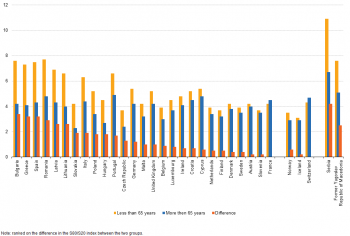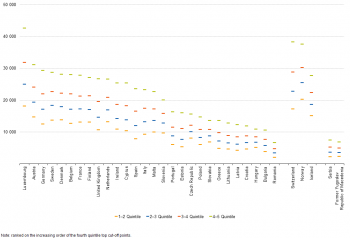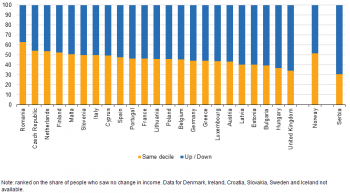Archive:Income inequality statistics
This article has been archived.
The largest share of total income goes to people belonging to the highest (fifth) quintile
This article presents data on income inequality, measured by the Gini coefficient, across the EU-28, three EFTA countries as well as the former Yugoslav Republic of Macedonia and Serbia. Income inequality is a complex phenomenon, the result of interaction between several factors. It can be related to employment patterns, income sources, individual characteristics (education level, age, gender, etc.) or household features (number of earners in the household, family size, etc.). Inequality is a broader concept than poverty; while poverty mainly relates to the lowest part of the income distribution, inequality takes into account the living conditions of all people in a society.
The analysis shows that the Czech Republic and Slovakia had the lowest level of inequality (as measured by the Gini coefficient) in the EU in 2014, and that the United Kingdom and Ireland had the highest. Overall, 13 EU Member States had a level of inequality higher than the EU-28 average in 2014. In Europe, 38.7 % of total equivalised income goes on average to people belonging to the highest (fifth) income quintile, and 7.7 % to people in the first quintile. This distribution of income explains the income discrepancies among people. It should be noted that inequality decreased in nine EU Member States in 2010–14.
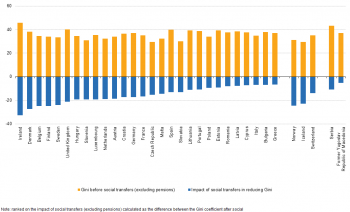
(scale from 0 to 100)
Source: Eurostat (ilc_di12) and (ilc_di12c)

Source: Eurostat (ilc_di12)

(%)
Source: Eurostat (ilc_di01) and (ilc_di11)
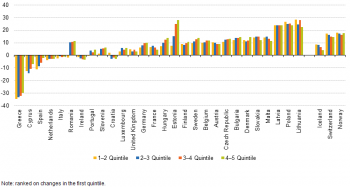
(%)
Source: Eurostat (ilc_di01)and (prc_hicp_aind)
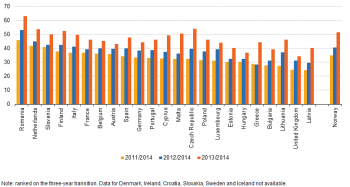
(%)
Source: Eurostat (ilc_di30a) and (ilc_di30b) and (ilc_di30c)
Main statistical findings
The Gini coefficient across the EU in 2014
The Gini coefficient reveals differences of approximately 16 points on average across the EU in 2014
In 2014, income inequality measured by the Gini coefficient varied by 16 points across the EU, with the lowest levels in the Czech Republic (29.6) and Slovakia (30.0) and the highest in the United Kingdom (40.1) and Ireland (45.6) (see Figure 1). Only a few EU Member States had an income inequality level around the EU-28 average of 36.5: Luxembourg (35.5), Croatia (36.5) and Greece (37.0). In 13 EU Member States, income discrepancies were above the EU-28 average, ranging from 37.0 in Greece to 45.6 in Ireland.
In the remaining countries, the income disparities were below or equal to the EU-28 average, ranging from 29.6 in the Czech Republic to less than 36.5 in Croatia. In summary, higher levels of inequality were recorded across southern Europe, but no dominant pattern was recorded in central and northern European countries.
Social transfers and inequality
Social transfers (excluding pensions) played an important role in reducing inequality in 2014
Figure 1 shows the Gini coefficients based on total equivalised disposable household income (see methodological note in the Data sources and availability section). These were calculated without including social transfers among the income sources, to measure the impact of these social transfers in reducing inequality.
As expected, income inequality would have been greater in all countries if social transfers were not included, with the highest values seen in Belgium, Denmark and Ireland and the lowest in Italy, Bulgaria and Greece. Social transfers played a crucial role in Ireland, where including them reduced inequality by around 33 % as measured by the Gini coefficient. They did not significantly affect inequality in eight countries where their inclusion among income sources reduced inequality by less than 10 %.
Evolution of inequality over time
Income disparities increased in Denmark and decreased in Iceland and Norway in 2010–2014
Although inequality in the EU-28 on average remained almost unchanged in 2010–2014, the pattern was more varied for individual countries (see Figure 2). Income discrepancies decreased or remained the same in ten EU Member States and in the three EFTA countries included in this analysis, and increased in the remaining countries. Despite their high levels of inequality in 2014, Lithuania, Croatia and the United Kingdom managed to reduce inequality compared with 2010 (by 5.4 %, 4.4 % and 4.0 % respectively).
Looking at the first 10 EU Member States with the lowest inequality levels in 2014, it appears that:
- Three of them recorded decreases in their income disparities since 2010 (Austria, Belgium and Malta).
- Seven recorded increases (the highest being in Sweden with 5.4 %). The largest decrease in inequality among EU Member States was reported by Malta, with a 3.1 % drop. When including EFTA countries, the biggest reduction was recorded in Iceland (– 11.7 %).
Income discrepancies across quintiles
On average in the EU in 2014, people in the highest income quintile earned nearly 39 % of total income, and people in the lowest quintile less than 8 %
The distribution of income among quintiles followed the same pattern in all EU Member States. In the EU-28, on average, 7.7 % of total income went to the first quintile, 38.7 % to the fifth quintile and 13.2 %, 17.5 % and 22.9 % went to the second, third and fourth quintiles respectively. In the Czech Republic and Finland, people in the first quintile earned around 10 % of total income (see Figure 3).
Another inequality measure that tells the same story
Figure 3 also showcases another tool to measure inequality, the S80/S20 index ( ), which supports the outcomes from the analysis of the Gini coefficient, but ranks countries in a slightly different order:
- Bulgaria, Spain and Romania recorded the highest levels of inequality (6.8 – 7.2)
- The Netherlands, Finland and the Czech Republic reported the lowest inequality levels (3.8 – 3.5).
This shows that high levels of inequality are caused by significant income discrepancies between the lower and upper parts of the income distribution scale.
Figure 4 shows the level of inequality measured by the S80/S20 index, for two age groups of people (less than 65 and more than 65). The main conclusion is that people aged under 65 experienced more inequality than people aged over 65, in all countries except France (and Switzerland, if EFTA countries are considered). The biggest differences were recorded in Estonia, Bulgaria, Greece and Spain (more than 3 points).
Different living conditions across countries
In 2014, the biggest income gap between the upper and lower part of the income distribution was seen in Luxembourg, and the smallest in Romania
Looking at income distribution in more detail, Figure 5 plots the income levels (with the top cut-off points [1] expressed in purchasing power standard (PPS)) related to each quintile. As expected, there were big differences between countries in 2014, reflecting differences in living standards. For example, belonging to the first quintile basically meant living in a household that earned around:
- On one side, around 2 000 PPS in Romania, less than 4 000 PPS in Bulgaria and around 4 300 PPS in Latvia.
- On the other, it meant living in a household that earned around 13 900 PPS in Denmark, 14 700 PPS in Austria and around 18 200 PPS in Luxembourg.
The highest quintile includes households that earned more than 42 700 PPS in Luxembourg, 31 200 PPS in Austria and 29 300 PPS in Germany, but it also included households that earned around 6 600 PPS in Romania and 10 600 PPS in Bulgaria (see Figure 5).
Figure 6 shows the change for different points on the income distribution (the top cut-off points for each quintile are in euros), in real terms, in 2010–2014 (income reference period 2009–2013). It shows the sensitivity of different points on the income distribution scale to changes over time in each country.
A decrease in each part of the income distribution scale is seen in nine EU Member States, with a consistent decrease in Ireland, Italy, the Netherlands, Spain, Cyprus and Greece. In the remaining countries, the incomes related to each top cut-off points were higher in 2014 than in 2010, with the biggest increases seen in Lithuania, Poland and Latvia.
Income mobility in 2011–2014
At least 34 % of the population stayed in the same decile in 2013–2014
The longitudinal component [2] of the EU-SILC instrument allows users to monitor income mobility issues. People can change their position on the income distribution scale over time, and can belong to different quintiles. This can also be related to how the financial situation of the other people living in the same country changes over time.
Looking at the income transitions in 2013–2014, at least 34 % of the population stayed in their original group, in all EU Member States, with the biggest percentage observed in Romania. This high percentage of people for whom income did not change is not surprising since the period for which the transition was computed was very short.
By contrast, mobility was quite high in Latvia, Estonia, Bulgaria, Hungary and the United Kingdom (around 60 % or more of the population) (see Figure 7). Looking at the people whose income position changed, their income mostly increased in 10 EU Member States, while it mostly decreased in 13 EU Member States.
When the transition period was increased to two or three years, income mobility increased everywhere. Moving from a one-year to a two-year transition, the percentage of the population that remained in the same decile of income distribution decreased in all countries. Furthermore, when the transition period was extended to three years, 30 % or more of the population saw no change in 18 EU Member States (from 30.2 % in Hungary to 45.9 % in Romania).
Data sources and availability
EU-SILC income reference period
The income reference period is a fixed 12-month period (such as the previous calendar or tax year) for all countries except the United Kingdom, for which it is the current year, and Ireland, for which the survey is continuous and income information is collected for the last twelve months. The data used in this publication comes from the EU-SILC 2012 report. With the exception of the United Kingdom and Ireland, the income reference period is therefore 1 January 2011 to 31 December 2011.
Gross income
Gross income includes income from market sources and cash benefits. The former includes employee cash or near-cash income, non-cash employee income, cash benefits from self-employment, income from rental of property or land, regular inter-household cash transfers received, interest, dividends, profit from capital investments in unincorporated businesses, income received by people aged under 16 and pensions from individual private plans. Cash benefits are the sum of all unemployment, old-age, survivor’s, sickness and disability benefits; education-related, family/children-related and housing allowances; and benefits for social exclusion or those not elsewhere classified. Direct taxes and regular inter-household cash transfers paid are deducted from gross income to give disposable income.
The current definition of total household disposable income used for calculating the indicators presented excludes imputed rent — i.e. money that the household saves on full (market) rent by living in its own accommodation or in accommodation it rents at a price that is lower than the market rent. The definition of income currently used also excludes non-monetary income components, in particular the value of goods produced for own consumption, social transfers in kind and non-cash employee income except company cars.
Equivalised disposable income
In order to reflect differences in household size and composition, the income figures are given per equivalent adult. This means that the total household income is divided by its equivalent size using the ‘modified OECD equivalence scale’ and the resulting figure is allocated to each member of the household, whether adult or children. The scale gives a weight of 1.0 to the first adult, 0.5 to any other household member aged 14 and over and 0.3 to each child below the age of 14. The equivalent size of a household that consists of 2 adults and 2 children below the age of 14 is therefore: 1.0 + 0.5 + (2 x 0.3) = 2.1. Equivalised disposable income is therefore an indicator of the economic resources available to a standardised household. For a lone-person household it is equal to household income. For a household comprising more than one person, it is an indicator of the household income that would be needed by a lone-person household to enjoy the same level of economic wellbeing.
Income quintiles and top cut-off points
Quintiles refer to the position in the frequency distribution. Quintiles divide a distribution into five parts so that we find 20 % of total observations in each quintile. The quintile cut-off value is obtained by sorting all income from lowest to highest, and then choosing the value of income under which 20 % (lower limit), 40 % (second limit), 60 % (third), 80 % (fourth) and 100 % (upper limit) of the sample are located. A quintile refers to the segment between the cut-off values of two quintiles. The first segment includes income below the lower quintile cut-off (20 %), the second segment includes income located between the lower cut-off and the second quintile cut-off, and so on.
Income quintile share ratio (S80/S20)
This is the ratio of the total income received by the 20 % of the country’s population with the highest disposable income (top quintile) to that received by the 20 % of the country’s population with the lowest disposable income (bottom quintile). EU and other aggregate values are calculated as the population-weighted averages of national indicators.
Gini coefficient
This index is the best-known index used to measure the level of income inequality in a particular country at one point in time. It ranges from 0 to 100, where 0 represents perfect equality in a society and 100 represents the maximum level of inequality. The Gini coefficient is based on the equivalised disposable income of each individual.
Social transfers
Social benefits are defined as transfers received by households during the income reference period to relieve them from the financial burden of certain risks or needs. In the analysis, social benefits and pensions include: unemployment benefits (PY090); old-age benefits (PY100); survivor’s benefits (PY110); sickness benefits (PY120); disability benefits (PY130); education-related allowances (PY140); family/children related allowances (HY050); social exclusion not included elsewhere (HY060); and housing allowances (HY070).
Inflation adjustment
In order to take account of inflation in year-to-year income changes, the HICP (Harmonised Index of Consumer Prices) is used. The HICP is the consumer price index as it is calculated in the European Union, according to a harmonised approach and a single set of definitions.
Purchasing power standard Purchasing power standard (PPS) is an artificial currency unit that would allow the purchase of the same basket of goods and services in different countries. PPS offsets differences in price levels between countries and thus allows real income to be compared.
EU average EU aggregates are calculated as the population-weighted averages of national indicators.
See also
- Children at risk of poverty or social exclusion
- Housing conditions
- Living standard statistics
- People at risk of poverty or social exclusion
Further Eurostat information
Publications
- Income and living conditions in Europe — 2014 edition — Statistical book
Main tables
Database
- Income and living conditions (ilc)
- Income distribution and monetary poverty (ilc_ip)
- Distribution of income (ilc_di)
- Income distribution and monetary poverty (ilc_ip)
Dedicated section
Methodology
Source data for tables, figures and maps (MS Excel)
Other information
- Regulation (EC) No 1177/2003 of 16 June 2003 concerning Community statistics on income and living conditions (EU-SILC)
- Regulation (EC) No 1980/2003 of 21 October 2003 implementing Regulation 1177/2003 concerning Community statistics on income and living conditions (EU-SILC) as regards definitions and updated definitions
Notes
